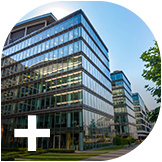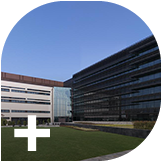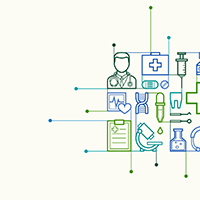From market access to real-world patient access: Closing the gap for biosimilar medicines
Biologics now represent around 40% of all pharmaceutical spending in Europe, and they’ve played a major role in transforming treatment outcomes in key disease areas such as cancer, autoimmune disorders, and diabetes. However, the complexity and cost of biologic development can challenge healthcare system sustainability, which can potentially delay timely and equitable access for patients.
Biosimilar medicines hold immense potential to shift this dynamic. These follow-on versions of biologic medicines typically enter the market once data exclusivity has expired, and offer the same therapeutic benefit, safety, and efficacy, but at a more affordable cost. By broadening access and generating significant savings that can be reinvested into patient care and future innovation, biosimilar medicines help make healthcare systems more sustainable.
Despite these benefits, biosimilar medicines remain under-recognised and underused in many markets. Real-world uptake often lags regulatory approval and reimbursement, creating a clear disconnect between market access and patient access. The reasons are complex, but the outcome is simple: patients miss out.
To close this gap, we need to look beyond just getting biosimilar medicines into market and focus on making the whole healthcare system ready – with the right policies, aligned incentives, and the trust of both prescribers and patients to support confident, widespread use.
Faster access starts with smarter, science-led regulation
Before optimising the post-market access landscape, biosimilar medicines must be set up for success from the very start. And the journey to patient impact begins with faster, more efficient regulatory approvals.
Since Sandoz received approval for Omnitrope in 2006, the first biosimilar medicine in Europe, the science behind their development has evolved significantly. With 69 biologics expected to lose protection by 2030 in Europe, the next five years presents a huge opportunity to expand access to these potentially life-changing medicines. However, to realise this potential, we must continue modernising and aligning regulatory guidance across regions – creating a more consistent, science-led approach that brings biosimilar medicines to patients without unnecessary delay.
Encouragingly, key regulators are starting to act. The European Medicines Agency recently published a draft reflection paper proposing that comparative efficacy trials be removed in most cases – a shift toward more streamlined approvals. This follows the UK Medicines and Healthcare Products Regulatory Agency’s 2022 update, which removed the default requirement for these trials where clear scientific rationale exists.
There’s also a growing opportunity for global convergence. Aligning regulatory pathways around the latest science could streamline development and bring biosimilar medicines to patients faster. For example, following Brazil’s 2022 introduction of a fast-track process for products approved by trusted international regulators, including the EMA, the Food and Drug Administration (FDA) and Health Canada, the number of approved biosimilar medicines in the country has grown significantly. This now positions Brazil among the top global markets for biosimilar authorisations, second only to the EU.
From streamlined approvals to timely launches, we need to fix the intellectual property (IP) bottleneck
Even with better regulatory pathways, biosimilar medicine launches can still be delayed by complex IP strategies that are often designed solely to restrict competition, as opposed to protecting innovation, and extend the reference product’s monopoly. These tactics drive up legal costs for developers and compromise timely patient access, putting long-term healthcare system sustainability at risk.
In Europe, this often involves divisional patents, where multiple overlapping patents are filed from a single application to prolong protection and create uncertainty. In the US, dense ‘patent thickets’ around single products can make litigation lengthy and expensive, even after regulatory approval. Both approaches extend exclusivity far beyond the original patent intent and can deter biosimilar medicine development entirely.
We need more balanced IP frameworks that protect genuine innovation while enabling timely, commercially viable biosimilar medicine entry. This includes greater transparency, discouraging duplicative filings, and streamlining legal processes. With clearer, fit-for-purpose IP systems, patient access expands, healthcare systems save billions, and manufacturers maintain the incentive to invest the significant time and capital required to bring a biosimilar medicine to the market.
We need pricing and procurement to support biosimilar medicine use once they enter the market
Biosimilar medicines have already delivered real value, helping to reduce biologic costs by up to 40% in Europe and generating over $12 billion in savings in the US alone in 2023. But as prices fall, a new challenge is emerging – reference biologics are lowering prices further and further to remain competitive, sometimes delivering savings without patients ever switching.
From a payer perspective, that may seem like a win, but it’s a short-sighted view. If biosimilar medicines aren’t being used, their future becomes uncertain, and while that might appear to affect mainly developers, the consequences are far more wide-reaching. Without biosimilar medicines in the market, the competitive pressure to keep prices low disappears, and with it the access benefits and cost savings that patients and healthcare systems rely on. We’re already seeing what happens when this dynamic breaks down. For example, we’re now facing a growing biosimilar void, where many biologic medicines have lost, or will lose, patent protection but have no biosimilar medicine candidate in development. In the US alone, this represents a missed savings opportunity of up to $189 billion over the next decade. Those lost savings don’t just impact today’s budgets; they also reduce the financial headroom for originator companies to invest in the treatments of tomorrow.
Tough launch conditions for biosimilar medicines can make this even harder. Mandatory discounts, external reference pricing, and automatic price cuts can make market entry for some molecules commercially unsustainable. Single-winner tenders focused only on the lowest price, and rebate structures that favour originators, further distort the market. With biosimilar medicine development taking up to nine years and $300 million per candidate, continued investment depends on fair, functional market conditions.
Moving forward, we need smarter frameworks that look beyond price alone and consider broader system value. Procurement should reward quality, supply resilience, and long-term value. Reimbursement systems must make biosimilar medicines a viable choice for prescribers by ensuring they are not financially disadvantaged for using them. Pricing models must promote healthy and sustainable competition over time. Ultimately, our systems must recognise biosimilar medicines as more than simply a short-term cost-containment tool. They are a strategic lever for value-based healthcare, helping health systems to stay sustainable while expanding access to life-changing biologic treatments for patients, both now and in the future.
The final barrier is trust, and we can’t build it without education and advocacy
Even if we have the right policies and systems in place, biosimilar medicines can only deliver their full impact if they’re being consistently and confidently used, and that still doesn’t happen often enough. Trust remains one of the biggest barriers, and despite real-world evidence demonstrating years of safe, effective use, hesitancy around biosimilar medicines is still common. Prescribers understandably want to feel confident in the medicines they recommend, and if they’re unsure, it stands to reason that patients will be too.
The industry has made real progress, but we’re not there yet. We need to keep investing in targeted, evidence-based education that speaks to the needs of prescribers, pharmacists, and patients. We also need to keep building strong advocacy networks with credible voices across healthcare systems that can reinforce trust and help make biosimilar medicines an even more mainstream aspect of patient care.
Because at the end of the day, no matter how strong the policy environment is, if prescribers don’t trust biosimilar medicines, patients won’t either. And without that trust, biosimilar medicines will always fall short of their full access potential.
Turning market entry into real-world patient access
Getting biosimilar medicines to market is an important milestone but it’s only part of the story. If we want these medicines to deliver on their full potential, we need to build systems that support real-world patient access. That means enabling confident use, supporting long-term sustainability, ensuring reliable supply, and building the trust needed to make biosimilar medicines a more natural part of care.
At Sandoz, our purpose is to pioneer access for patients. That’s not just about developing high-quality biosimilar medicines, it’s also about driving the changes needed to help them succeed once they’re available.
But we can’t do it alone. Making biosimilar medicines work at scale takes strong collaboration across industry, regulators, policymakers, payers, and healthcare professionals. If we can come together with a shared commitment to improving access, we can build a system where biosimilar medicines can reach more people, more reliably, and make an even bigger impact with the patients who need them the most.
About Sandoz
Sandoz (SIX: SDZ; OTCQX: SDZNY) is the global leader in generic and biosimilar medicines, with a growth strategy driven by its Purpose: pioneering access for patients. More than 20,000 people of 100 nationalities work together to ensure 900 million patient treatments are provided by Sandoz, generating substantial global healthcare savings and an even larger social impact. Its leading portfolio of approximately 1,300 products addresses diseases from the common cold to cancer. Headquartered in Basel, Switzerland, Sandoz traces its heritage back to 1886. Its history of breakthroughs includes Calcium Sandoz in 1929, the world’s first oral penicillin in 1951, and the world’s first biosimilar in 2006. In 2024, Sandoz recorded net sales of USD 10.4 billion.
About the author
Rebecca Guntern is chief commercial officer at Sandoz. Previously she led the European commercial organisation as president, Europe across more than 40 countries, beginning in 2020. She is a senior business leader with over 25 years of international experience in the pharmaceutical and healthcare industry. She joined Sandoz in 2007 as head of sales and has held positions of increasing leadership responsibility since then. Prior to joining Sandoz, Guntern worked for other leading pharmaceutical companies, such as Roche and Merck Sharpe & Dohme.
Guntern is also a member of the board of directors of BKW AG in Switzerland, where she chairs the nomination and compensation committee. She holds a Master’s degree in Pharmacy from the University of Basel, as well as a Bachelor’s degree in Business Administration.
Supercharge your pharma insights: Sign up to pharmaphorum's newsletter for daily updates, weekly roundups, and in-depth analysis across all industry sectors.
Want to go deeper?
Continue your journey with these related reads from across pharmaphorum
Click on either of the images below for more articles from this edition of Deep Dive: Market Access and Commercialisation 2025












